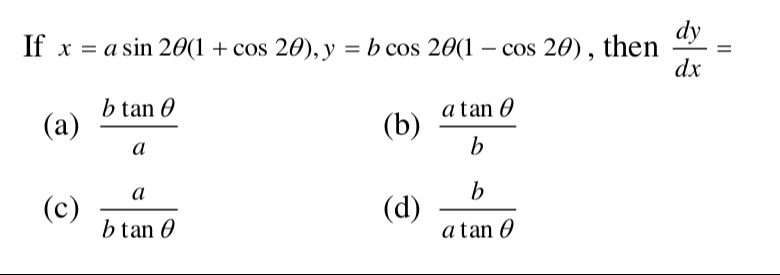Question
Question: If $x = a \sin 2\theta(1 + \cos 2\theta), y = b \cos 2\theta(1 - \cos 2\theta)$, then $\frac{dy}{dx}...
If x=asin2θ(1+cos2θ),y=bcos2θ(1−cos2θ), then dxdy=

abtanθ
batanθ
btanθa
atanθb
abtanθ
Solution
Given the parametric equations: x=asin2θ(1+cos2θ) y=bcos2θ(1−cos2θ)
We need to find dxdy=dx/dθdy/dθ.
First, let's calculate dθdx. x=a(sin2θ+sin2θcos2θ) Using the identity sinAcosB=21(sin(A+B)+sin(A−B)), or more simply sin2θcos2θ=21sin(2θ+2θ)=21sin4θ. So, x=a(sin2θ+21sin4θ).
Now, differentiate x with respect to θ: dθdx=a(dθd(sin2θ)+21dθd(sin4θ)) dθdx=a((2cos2θ)+21(4cos4θ)) dθdx=a(2cos2θ+2cos4θ) dθdx=2a(cos2θ+cos4θ) Using the sum-to-product identity cosA+cosB=2cos2A+Bcos2A−B: cos2θ+cos4θ=2cos22θ+4θcos22θ−4θ=2cos3θcos(−θ)=2cos3θcosθ. So, dθdx=2a(2cos3θcosθ)=4acos3θcosθ.
Alternatively, using the identities 1+cos2θ=2cos2θ and sin2θ=2sinθcosθ: x=a(2sinθcosθ)(2cos2θ)=4asinθcos3θ. Differentiate x with respect to θ using the product rule: dθdx=4a(dθd(sinθ)cos3θ+sinθdθd(cos3θ)) dθdx=4a((cosθ)cos3θ+sinθ(3cos2θ(−sinθ))) dθdx=4a(cos4θ−3sin2θcos2θ) dθdx=4acos2θ(cos2θ−3sin2θ) Using sin2θ=1−cos2θ: dθdx=4acos2θ(cos2θ−3(1−cos2θ))=4acos2θ(cos2θ−3+3cos2θ)=4acos2θ(4cos2θ−3). Using cos2θ=2cos2θ−1, so 2cos2θ=1+cos2θ: 4cos2θ−3=2(2cos2θ)−3=2(1+cos2θ)−3=2+2cos2θ−3=2cos2θ−1. So, dθdx=4acos2θ(2cos2θ−1).
Next, calculate dθdy. y=b(cos2θ−cos22θ). Differentiate y with respect to θ: dθdy=b(dθd(cos2θ)−dθd(cos22θ)) dθdy=b((−2sin2θ)−(2cos2θ⋅(−2sin2θ))) dθdy=b(−2sin2θ+4sin2θcos2θ) dθdy=2bsin2θ(−1+2cos2θ) dθdy=2bsin2θ(2cos2θ−1).
Now, calculate dxdy=dx/dθdy/dθ. dxdy=4acos2θ(2cos2θ−1)2bsin2θ(2cos2θ−1). Assuming 2cos2θ−1=0, we can cancel the term (2cos2θ−1). dxdy=4acos2θ2bsin2θ Using the identity sin2θ=2sinθcosθ: dxdy=4acos2θ2b(2sinθcosθ) dxdy=4acos2θ4bsinθcosθ dxdy=acosθbsinθ dxdy=abtanθ.
This matches option (a).
